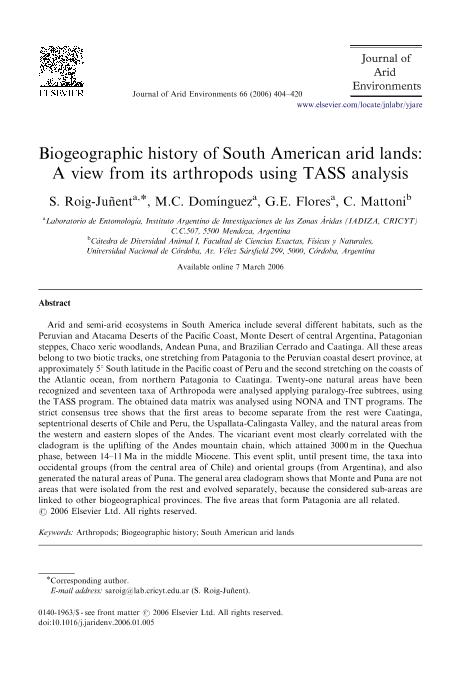Mostrar el registro sencillo del ítem
dc.contributor.author
Roig, Sergio Alberto

dc.contributor.author
Dominguez, Martha Cecilia

dc.contributor.author
Flores, Gustavo Ernesto

dc.contributor.author
Mattoni, Camilo Ivan

dc.date.available
2019-12-26T15:24:28Z
dc.date.issued
2006-12
dc.identifier.citation
Roig, Sergio Alberto; Dominguez, Martha Cecilia; Flores, Gustavo Ernesto; Mattoni, Camilo Ivan; Biogeographic history of South American arid lands: A view from its arthropods using TASS analysis; Academic Press Ltd - Elsevier Science Ltd; Journal of Arid Environments; 66; 3; 12-2006; 404-420
dc.identifier.issn
0140-1963
dc.identifier.uri
http://hdl.handle.net/11336/92925
dc.description.abstract
Arid and semi-arid ecosystems in South America include several different habitats, such as the Peruvian and Atacama Deserts of the Pacific Coast, Monte Desert of central Argentina, Patagonian steppes, Chaco xeric woodlands, Andean Puna, and Brazilian Cerrado and Caatinga. All these areas belong to two biotic tracks, one stretching from Patagonia to the Peruvian coastal desert province, at approximately 5° South latitude in the Pacific coast of Peru and the second stretching on the coasts of the Atlantic ocean, from northern Patagonia to Caatinga. Twenty-one natural areas have been recognized and seventeen taxa of Arthropoda were analysed applying paralogy-free subtrees, using the TASS program. The obtained data matrix was analysed using NONA and TNT programs. The strict consensus tree shows that the first areas to become separate from the rest were Caatinga, septentrional deserts of Chile and Peru, the Uspallata-Calingasta Valley, and the natural areas from the western and eastern slopes of the Andes. The vicariant event most clearly correlated with the cladogram is the uplifting of the Andes mountain chain, which attained 3000 m in the Quechua phase, between 14-11 Ma in the middle Miocene. This event split, until present time, the taxa into occidental groups (from the central area of Chile) and oriental groups (from Argentina), and also generated the natural areas of Puna. The general area cladogram shows that Monte and Puna are not areas that were isolated from the rest and evolved separately, because the considered sub-areas are linked to other biogeographical provinces. The five areas that form Patagonia are all related.
dc.format
application/pdf
dc.language.iso
eng
dc.publisher
Academic Press Ltd - Elsevier Science Ltd

dc.rights
info:eu-repo/semantics/openAccess
dc.rights.uri
https://creativecommons.org/licenses/by-nc-sa/2.5/ar/
dc.subject
ARTHROPODS
dc.subject
BIOGEOGRAPHIC HISTORY
dc.subject
SOUTH AMERICAN ARID LANDS
dc.subject.classification
Zoología, Ornitología, Entomología, Etología

dc.subject.classification
Ciencias Biológicas

dc.subject.classification
CIENCIAS NATURALES Y EXACTAS

dc.title
Biogeographic history of South American arid lands: A view from its arthropods using TASS analysis
dc.type
info:eu-repo/semantics/article
dc.type
info:ar-repo/semantics/artículo
dc.type
info:eu-repo/semantics/publishedVersion
dc.date.updated
2019-12-05T13:35:00Z
dc.journal.volume
66
dc.journal.number
3
dc.journal.pagination
404-420
dc.journal.pais
Países Bajos

dc.journal.ciudad
Amsterdam
dc.description.fil
Fil: Roig, Sergio Alberto. Consejo Nacional de Investigaciones Científicas y Técnicas. Centro Científico Tecnológico Conicet - Mendoza. Instituto Argentino de Investigaciones de las Zonas Áridas. Provincia de Mendoza. Instituto Argentino de Investigaciones de las Zonas Áridas. Universidad Nacional de Cuyo. Instituto Argentino de Investigaciones de las Zonas Áridas; Argentina
dc.description.fil
Fil: Dominguez, Martha Cecilia. Consejo Nacional de Investigaciones Científicas y Técnicas. Centro Científico Tecnológico Conicet - Mendoza. Instituto Argentino de Investigaciones de las Zonas Áridas. Provincia de Mendoza. Instituto Argentino de Investigaciones de las Zonas Áridas. Universidad Nacional de Cuyo. Instituto Argentino de Investigaciones de las Zonas Áridas; Argentina
dc.description.fil
Fil: Flores, Gustavo Ernesto. Consejo Nacional de Investigaciones Científicas y Técnicas. Centro Científico Tecnológico Conicet - Mendoza. Instituto Argentino de Investigaciones de las Zonas Áridas. Provincia de Mendoza. Instituto Argentino de Investigaciones de las Zonas Áridas. Universidad Nacional de Cuyo. Instituto Argentino de Investigaciones de las Zonas Áridas; Argentina
dc.description.fil
Fil: Mattoni, Camilo Ivan. Universidad Nacional de Córdoba. Facultad de Ciencias Exactas, Físicas y Naturales; Argentina
dc.journal.title
Journal of Arid Environments

dc.relation.alternativeid
info:eu-repo/semantics/altIdentifier/doi/http://dx.doi.org/10.1016/j.jaridenv.2006.01.005
dc.relation.alternativeid
info:eu-repo/semantics/altIdentifier/url/https://www.sciencedirect.com/science/article/pii/S0140196306000358
Archivos asociados
